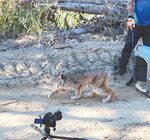

INCHELIUM – Missing lynx are making a comeback on the Colville Reservation thanks to a cooperative trap and release project between Canadian and Colville Confederated Tribes (CCT) wildlife staff.
Ten Canada lynx were recently trapped in British Columbia, Canada, and relocated to their new home on the Colville Indian Reservation (CIR). Nine of the cats were released last year when the project began.
“The trapping went well this year, and the team was able to catch and relocate 10 adult lynx in about one month,” said Corey Peone, Inchelium CCT District wildlife biologist. “The trapping efforts started in early October and ended in early November. Our goal was to catch them before the big snowfall arrived and the final lynx was caught the day after the first big snowstorm.”
Lynx is not a listed species in Canada so it is legal to trap them there. In Washington state, Canada lynx are listed as a federally threatened species so multiple permits are required to transport these animals across the border.
“When I was in Canada we caught three lynx in one day, so I got to work with these three toms from the trap to the release site,” said Elizabeth Odell, Inchelium assistant district wildlife biologist for CCT.
The trapped lynx are placed in a kennel, transported to a less stressful dark, quiet space for processing and evaluation.
“We let the lynx calm down and once they are drugged, we proceed to monitor their vitals including respiratory rate, temperature, gum color, and heart rate,” said Odell. “We take their weight, secure a GPS collar, place an ear tag, and note the body condition and overall health.”
Once a veterinarian confirms that the lynx is healthy the cat is monitored every few minutes until the animal is awake and alert. Once awake, the lynx is offered raw chicken to provide some calories for the upcoming trip. Transport from Kelowna, B.C., to the border takes two hours and once through customs, another 2.5 to 3 hours to drive to the release site on the CIR.
“Every lynx that is released is fitted with a GPS satellite collar that tracks its movement on a daily basis,” said Rose Piccinini, Sanpoil district wildlife biologist for CCT. “The first year of monitoring showed us so much and it's amazing to document how they are utilizing the landscape.”
The majority of the lynx were dispersed along the backbone of the Kettle Crest with the majority of those staying south of Boulder Pass.
“Over the course of the year, we had two males and two females return to Canada,” said Piccinini. “One of the females traveled south again and has returned to the North Half. During summer monitoring, we were able to confirm that one female reproduced. We have camera sets out to verify the survival of the kittens and we will continue to monitor her this winter.”
The CCT teamed up with Conservation Northwest, Upper Columbia United Tribes (UCUT), Okanagan Nation Alliance (ONA), and others to capture and relocate these large cats to the CIR. The goal of the project is to relocate at least 50 Canada lynx to the reservation in the next five years.
“It was an amazing year,” said Dave Werntz, science and conservation director for Conservation Northwest. “The Tribe’s wildlife staff, trappers, ONA, UCUT, and other partners showed up strong for another successful year supporting lynx recovery. We made some changes based on last years’ experience to improve trap performance, surmount weather and mechanical obstacles, simplify logistics, and ensure efficient and humane lynx care. And it worked.”
Lynx numbers have been low in the Kettle Range due to historic overharvesting (fur trapping), According to Werntz. The vast majority of lynx documented in Washington between 1964 and 1984 occurred in northeast Washington, mostly in the Kettle Range. Werntz believes moving lynx to the Kettle Range from a robust lynx population from the north will work.
“We commissioned a scientific analysis that showed a substantial amount of suitable habitat for lynx in the Kettle Range that could support 12-40 lynx depending on their home range size,” said Werntz.
The Kettle Range was identified by federal biologists as one of six core areas essential to the continued persistence of lynx due to its extent of suitable habitat, connection to British Columbia, and quality snow and prey conditions.
Colville Tribes Fish and Wildlife received support and funding from the Bureau of Indian Affairs, the U.S. Fish and Wildlife Service, Conservation Northwest, the National Fish and Wildlife Foundation, Conservation Research and Education Opportunities International (CREOi), and the Volgenau Foundation.
Comments
No comments on this item Please log in to comment by clicking here